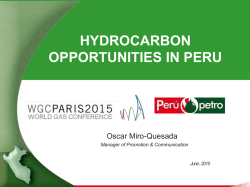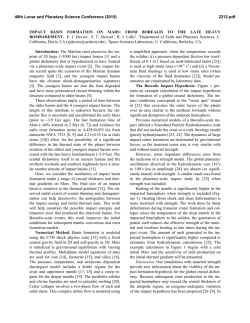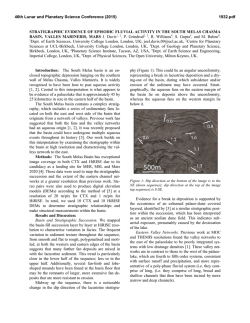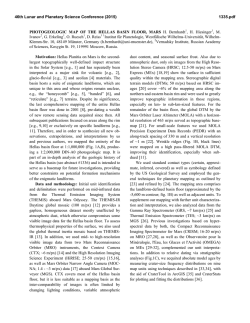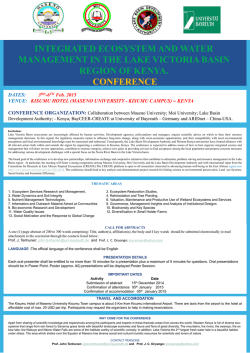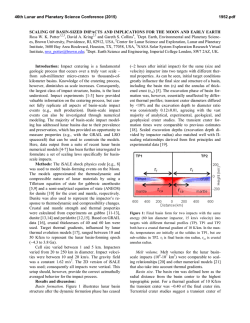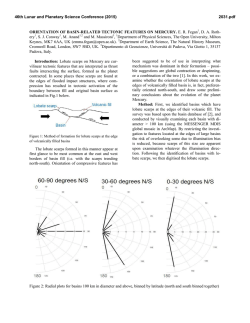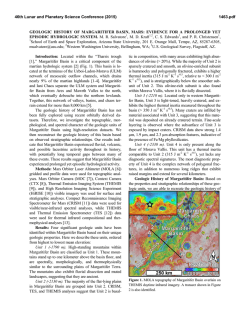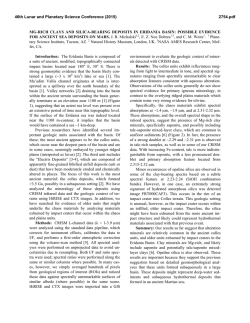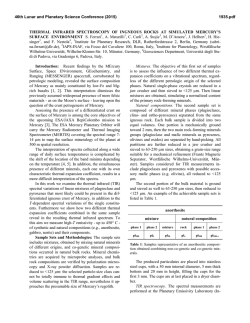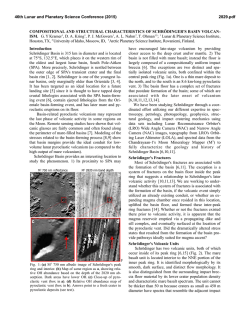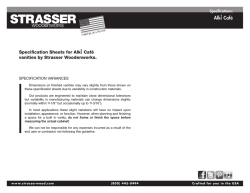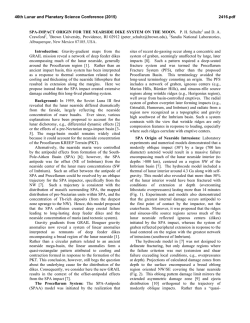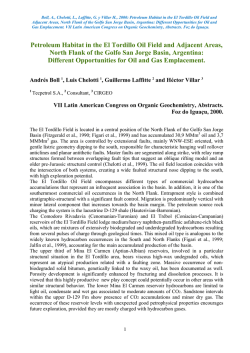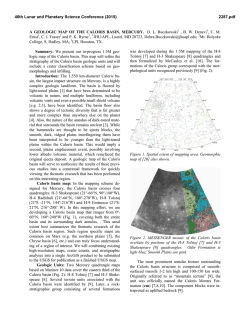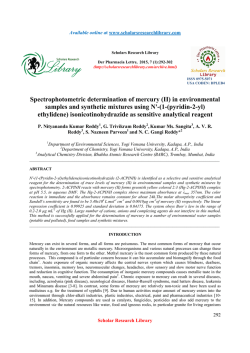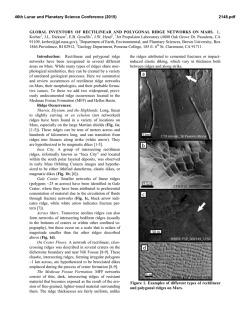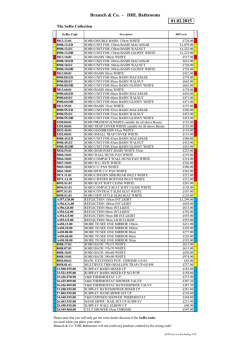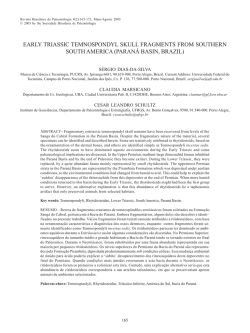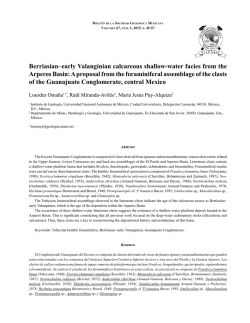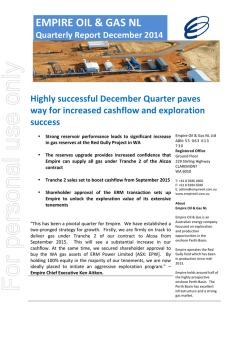
Geology of the Vincente-Yakovlev Basin Region on Mercury
46th Lunar and Planetary Science Conference (2015) 2634.pdf GEOLOGY OF THE VINCENTE-YAKOVLEV BASIN REGION ON MERCURY: IMPLICATIONS FOR BASIN CONTROL OF SUBSEQUENT TECTONISM. S. L. André, Planetary Science Institute, 1700 East Lowell Road, Suite 106, Tucson, Arizona 85719, [email protected]. Introduction: NASA’s MErcury Surface, Space ENvironment, GEochemistry, and Ranging (MESSENGER) spacecraft has returned image data that allows for the detailed study of the surface of the planet Mercury [1,2]. Previous studies using Mariner 10 spacecraft images recognized the importance of large impact basins as subsequently affecting the evolution of the surface of the planet [3-11]. Recent studies using MESSENGER orbital data have allowed for the identification of previously unobserved basins [i.e. 12]. Another recent study [13] identified impact basins with compressional tectonic features localized along the interface between basin fill and the inner basin walls. Common tectonic landforms of Mercury that express horizontal shortening are lobate scarps, wrinkle ridges, and high-relief ridges [i.e. 14,15]. Tectonic studies have proposed that areas of heavily cratered terrain have been strongly influenced by the presence of ancient multi-ring impact basins, specifically that these basins have controlled the distribution of plains materials and influenced structural trends [i.e. 11]. The geology of a site [11] where degraded basins may have influenced structural trends was examined, to determine how the various assemblages of features are related through crosscutting and superposition relationships. The goal of this study is to quantify the observed structural trends within a region on Mercury, and investigate what influence degraded basins may have had on the resulting orientation and morphology of subsequent tectonic landforms. Data and Methods: Image data collected during MESSENGER’s orbital phase and flybys and available in the Planetary Data System were analyzed. MESSENGER image data from the Wide Angle Camera (WAC) and Narrow Angle Camera (NAC) [1,2] were map projected and mosaicked using the USGS Integrated Software for Imagers and Spectrometers (ISIS) [16]. The monochrome base map images have an average of ~250 m/pixel spatial resolution. Color images were acquired during global mapping and have a resolution of ~1000 m/pixel [2]. Targeted images of select areas were acquired, often at resolutions between ~300 m/pixel to 20 m/pixel [2]. The initial study area is a region (Figure 1) located within the Michelangelo quadrangle of the southern hemisphere of Mercury. This region contains basins that have undergone a variety of modification processes. Impact features range in relative age, including an ancient degraded basin (Vincente-Yakovlev) to younger simple bowl-shaped craters. Geologic sketch maps were produced from the WAC and NAC image mosaic base map images using Adobe Photoshop. General unit identifications were based on texture, albedo, and visibility of contact with neighboring units. When necessary, images with differing incidence angles were used to better identify landforms and unit contacts. Figure 1. A MESSENGER NAC and WAC mosaic of the area of 35°S to 70°S and -150°E and -180°E. The locations of Figures 2 and 3 are indicated by white outlines. A 20° by 20° grid of latitude and longitude is shown (white lines). The resolution of the mosaic is 255 m/pixel. The degraded Vincente-Yakovlev basin is centered in the figure at 52.6°S and -162.1°E, with a diameter of 690 km. Results: The area exhibits a complex sequence of tectonic modification, determined through geologic context and crosscutting relationships. The orientations of observed tectonic features (lineaments associated with scarps, ridges, and polygonal crater walls) were quantified to identify if correlation with the preexisting basin topography exists. Figure 2 highlights an area where the rim of Vincente-Yakovlev basin and the rim of Dostoevskij, a 390 km diameter impact crater, intersect. Figure 3 shows an example of a series of wrinkle ridges observed within the center of the 46th Lunar and Planetary Science Conference (2015) 2634.pdf Vincente-Yakovlev interior plains unit. Several lobate scarps, including the 700 km long Hero Rupes, are localized near the southern rim of the VincenteYakovlev basin. Figure 3. Located within the center of the VincenteYakovlev basin, the top white arrow indicates the rim of a ghost crater. Commonly observed on the surface of Mercury, ghost craters are impact craters subsequently buried by plains material [15]. The smaller arrows to the right illustrate several small-scale wrinkle ridges observed within the center of the basin. Figure 2. The intersection of the Vincente-Yakovlev basin and the rim (white arrows) of Dostoevskij, a 390 km diameter impact crater located to the northwest of the basin. Future Work: Altimetry data from the MESSENGER MLA instrument provides topography information for the northern hemisphere [17]; however, the southern hemisphere topography must be derived from stereo-images. Preliminary work on a stereo-image-derived global topography map has been performed by the MESSENGER team [17,18]; however, corrections for the camera models for the MDIS WAC and NAC instruments are being refined [19]. Once the necessary camera model corrections have been achieved and digital terrain maps constructed, a more detailed analysis of the Vincente-Yakovlev region will be performed incorporating topography data. References: [1] Hawkins S E. (2007) Space Sci. Rev., 131, 247-338. [2] Solomon S. C. et al. (2007) Space Sci. Rev., 131, 2-29. [3] Murray B. C. et al. (1974) Science, 185, 169-179. [4] Trask N. J. and Guest J. E. (1975) JGR, 80, 2461-2477. [5] Wood C. A. and Head J. W. (1976) Proc. Lunar. Plan. Sci. Conf., 7, 3629-3651. [6] Malin M. C. (1976) Proc. Lunar. Planet. Sci. Conf., 7, 3589-3602. [7] Frey H. and Lowry B. L. (1979) Proc. Lunar. Planet. Sci. Conf., 10, 2669-2687. [8] Spudis P. (1993) Geol. Multi-ring Impact Basins, Cambridge Univ. Press. [9] Pike R. J. (1988) in Mercury, Univ. AZ Press, Tucson, AZ, 165-273. [10] Cordell B. M. and Strom R. G. (1977) Phys. Earth. Plan. Inter., 15, 146-155. [11] Spudis P. and Prosser J. G. (1984) U.S. Geol. Surv. Misc. Invest. Series, I-1659. [12] Fassett C. I. et al. (2012) JGR, 117, E00L08. [13] Rothery D. A. and Massironi M. (2013) LPSC 43, Abstract #1175. [14] Watters T. R. et al. (2009) EPSL, 285, 283-296. [15] Watters T. R. et al. (2012) Geology, 40, 1123-1126. [16] Anderson J. A. et al. (2004) LPSC 35, Abstract #2039. [17] Pruesker F. et al. (2011) Planet. Space Sci., 59, 1910-1917. [18] Zuber M. et al. (2012) Science, 336, 217-220. [19] Becker K. et al. (2014) LPSC 45, Abstract #2243.
© Copyright 2025
